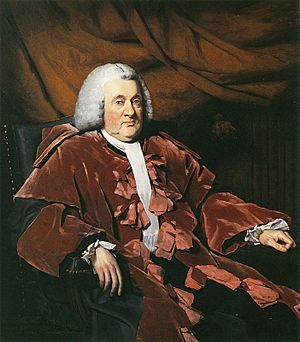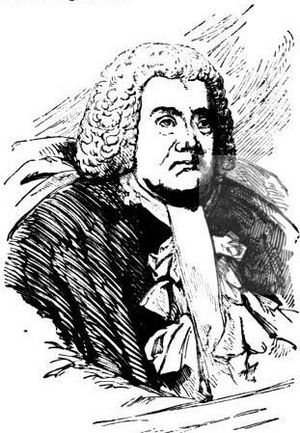Robert Dundas of Arniston, the younger facts for kids
Quick facts for kids
The Much Honoured
Lord Arniston
FRSE
|
|
|---|---|

Portrait of Dundas by Henry Raeburn
|
|
| Lord President of the Court of Session Lord Justice General |
|
| In office 30 April 1760 – 13 December 1787 |
|
| Appointed by | George III |
| Preceded by | Robert Craigie |
| Succeeded by | Thomas Miller |
| Member of Parliament for Midlothian | |
| In office 1754–1761 |
|
| Preceded by | Robert Balfour-Ramsay |
| Succeeded by | Sir Alexander Gilmour |
| Lord Advocate | |
| In office 1754–1760 |
|
| Preceded by | William Grant |
| Succeeded by | Thomas Miller |
| Solicitor General for Scotland | |
| In office 1742–1746 |
|
| Preceded by | William Grant |
| Succeeded by | Patrick Haldane |
| Personal details | |
| Born | 18 July 1713 |
| Died | 13 December 1787 (aged 74) Adam's Square, Edinburgh |
| Resting place | Borthwick |
| Political party | Whig |
| Spouses |
Henrietta Baillie
(m. 1741; died 1755)Jean Grant
(m. 1756) |
| Children | 8, including Robert, Francis, William, Philip |
| Parents | Robert Dundas of Arniston Elizabeth Watson |
| Alma mater | University of Edinburgh Utrecht University |
| Profession | Advocate, Judge, Politician |
Robert Dundas of Arniston (born July 18, 1713 – died December 13, 1787) was an important Scottish judge. He held several key roles in the government and legal system. He was a top lawyer, serving as Solicitor General for Scotland and Lord Advocate. He also represented Midlothian in the British Parliament. Later, he became the highest judge in Scotland, the Lord President of the Court of Session.
Contents
Life as a Judge and Politician
Robert Dundas was the oldest son of Robert Dundas of Arniston, who was also a famous judge. Robert Jr. studied at the University of Edinburgh and then at Utrecht University in the Netherlands. He became a lawyer, known as an advocate, in 1738. He was very smart and good at speaking.
Early Legal Career
Robert Dundas was appointed Solicitor General for Scotland in 1742. This role meant he was a senior lawyer working for the government. He held this position during a difficult time, including the Jacobite rising of 1745. He later became the dean of the faculty, which is a leader among lawyers.
In 1754, he became Lord Advocate, another very important legal role for the government. At the same time, he was elected as a Member of Parliament for Midlothian. As Lord Advocate, he helped manage the changes happening in the Scottish Highlands.
Leading the Court of Session
In 1760, Robert Dundas became the Lord President of the Court of Session. This was the top judge position in Scotland. When he started, there were many cases waiting to be decided. He worked hard to clear them all. He made sure that cases were heard quickly and fairly. People thought he was an excellent judge. He was known for being fair and making clear decisions.
The Douglas Cause
One of the most famous cases he dealt with was the Douglas Cause in 1767. This was a big legal dispute about who should inherit a noble title and a lot of money. Robert Dundas had the deciding vote in the case. He voted against Archibald Douglas. This decision made him very unpopular with many people. When a higher court later changed the decision, crowds in Edinburgh celebrated loudly. They even attacked his house because they were so upset with his earlier vote.
Robert Dundas continued to serve as Lord President until he died in 1787. His tomb is in Borthwick Church.
Family Connections
Robert Dundas came from a very important family of lawyers and politicians in Scotland. His great-grandfather, grandfather, and father were all Members of Parliament and judges.
Robert Dundas married twice. He had four daughters with his first wife, Henrietta Baillie. After she passed away, he married Jean Grant and had four sons and two daughters. Many of his children also had successful careers:
- His oldest son, Robert, also became a Lord Advocate.
- Francis became a general and even acted as governor of the Cape Colony.
- William became a lawyer and a Member of Parliament.
- Philip became a governor of Prince of Wales Island.
Images for kids



